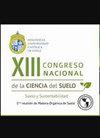PELLETIZATION OF Anthracophyllum discolor FOR WATER AND SOIL TREATMENT CONTAMINATED WITH ORGANIC POLLUTANTS
Revista De La Ciencia Del Suelo Y Nutricion Vegetal
Pub Date : 2009-01-01
DOI:10.4067/S0718-27912009000300001
引用次数: 7
Abstract
Pellets of the white-rot fungus Anthracophyllum discolor with activated carbon and sawdust (complex pellets) were formulated for the degradation of lignin in water and the bioremediation of soil contaminated with pentachlorophenol (PCP). The complex pellets were formed by a center of activated carbon and sawdust surrounded by fungal mycelium, whereas simple pellets consisting of only mycelium were hollow spheres. Degradation of lignin was performed in an airlift reactor at initial lignin concentration of 1000 mg L -1 and the fungal pellets were re-used two times in batch operations. Complex pellets degraded lignin by 87 and 72% in the first and second cycle, respectively, and they were significantly more effective than simple pellets. In addition, complex pellet showed higher manganese peroxidase activity in the reactor. For the bioremediation of soil contaminated with PCP (150 mg kg -1 of soil) the pellets were added to soil surface. PCP degradation in soil with complex pellets was 85% at 28 days of bioaugmentation, being higher than in soil with simple pellet. A fungus growth was also observed only in soil with complex pellet. Sawdust and activated carbon appear to be suitable carriers of A. discolor for degradation of organic pollutants in wastewater and soil.炭疽菌脱色制粒法处理受有机污染物污染的水和土壤
采用活性炭和木屑制备了白腐菌炭疽菌变色颗粒(复合颗粒),用于降解水中木质素和修复五氯酚污染的土壤。复合球是由活性炭和木屑的中心包裹在真菌菌丝体中形成的,而仅由菌丝体组成的简单球是空心球体。在初始木质素浓度为1000 mg L -1的气升反应器中进行木质素降解,真菌球团在间歇操作中重复使用两次。复合颗粒在第一次和第二次循环中降解木质素的效率分别为87%和72%,显著高于简单颗粒。此外,复合球团在反应器中表现出较高的锰过氧化物酶活性。将颗粒投加到土壤表面,对受PCP污染的土壤(150 mg kg -1)进行生物修复。生物强化28 d时,复合颗粒土壤对PCP的降解率为85%,高于单纯颗粒土壤。真菌也只在具有复杂颗粒的土壤中生长。木屑和活性炭是褐藻降解废水和土壤中有机污染物的适宜载体。
本文章由计算机程序翻译,如有差异,请以英文原文为准。
求助全文
约1分钟内获得全文
求助全文

 求助内容:
求助内容: 应助结果提醒方式:
应助结果提醒方式:


